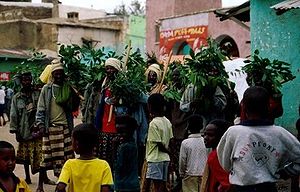Rainmaking (ritual)

A rain dance is a ceremonial dance that is performed in order to invoke rain and to ensure the protection of the harvest.
Various interpretations of "rain dances" can be found in many cultures, from Ancient Egypt to certain Native American tribes. They could still be found in the 20th century Balkans, in a ritual known as Paparuda (Romanian) or Perperuna (Slavic).
The Cherokee tribe, an ethnic Native American tribe from the Southeastern United States, including Southern Appalachia, performed rain dances to both induce precipitation and to cleanse evil spirits from the earth [1]. The legend of the tribe holds that the rain summoned by the tribe contains the spirits of past tribal chiefs, who, when falling, battle evil spirits in the transitional plane between our reality and the spirit world.[2] It was also believed that particularly elaborate rain dances could inspire the participants, as well as audience, to partake in unusual and extreme acts of worship.
A story from the indigenous peoples of the United States relates how the term "Rain Dance" came into being. The story holds that, during the days of the Native American relocation, certain religious ceremonies (amongst them the Rain Dance and Ghost Dance) were banned by the government. The tribes in suppressed areas were forbidden to perform the Sun Dance. The Windigokan, a nominally cannibalistic sect, nicknamed "the backward people," became famous for telling federal representatives that the dance being performed was not the Sun Dance, but the Rain Dance, thus preventing any prosecution or federal intervention.
Julia M. Butree (a wife of Ernest Thompson Seton) in her book,[3] among other Native American dances describes the "Rain Dance of Zuni"[4]
Feathers and turquoise are worn during the ceremony to symbolize wind and rain respectively. Many traditions of the Rain Dance are passed down through history by oral traditions[5]
Hacker's jargon
The Jargon File of hackers' lore[6] describes an idiomatic usage of the term:
- Any ceremonial action taken to correct a hardware problem, with the expectation that nothing will be accomplished. This especially applies to reseating printed circuit boards, reconnecting cables, etc. “I can't boot up the machine. We'll have to wait for Greg to do his rain dance.”
- Any arcane sequence of actions performed with computers or software in order to achieve some goal; the term is usually restricted to rituals that include both an incantation or two and physical activity or motion. Compare black magic, voodoo programming, cargo cult programming, wave a dead chicken; see also casting the runes.
References
- ^ Rain's Dance Group
- ^ http://dizzy.library.arizona.edu/images/eng102/toodham/ceremony_page.html
- ^ Julia M. Butree (Julia M. Seton) The Rhythm of the Redman : in Song, Dance and Decoration. New York, A. S. Barnes, 1930
- ^ Rain Dance of Zuni
- ^ The rain dance helped native americans get through dry summers
- ^ Jargon File, version 4.4.6, 25 October 2003
